Costing in Oracle Shop Floor Management
The Oracle Cost Management User's Guide is a prerequisite for understanding this chapter. Since lot based jobs use Standard Costing, sections specific to other costing methods may be skipped.
This chapter covers the following topics:
- Overview of Lot Based Job Costing
- Cost Rollup for Network Routings
- Standard Cost Update for Lot Based Jobs
- Phantom Routings
- Lot Based Jobs Transaction Costing
- Move Transaction Costing
- Estimated Scrap Accounting
- Operation Yield
- Disabling Estimated Scrap and Operation Yield Accounting
- Non Standard Expense Lot Based Jobs
- WIP Lot Based Jobs Transaction Costing
- Lot Split Transactions
- Merge Lots
- Bonus Lots
- Update Quantity
- Update Routing and Update Assembly
- Lot Based Transaction are Integrated into Cost Manager
- Transaction Import through MES
- WIP Value Summary
- Reports
Overview of Lot Based Job Costing
Many companies, such as those in the semiconductor industry, need to account for estimated scrap at each operation of a job. Operation yield is expressed as the compliment of the estimated scrap at each operation. When defining an item's routing, you can enter operation yields at each operation on that routing, and specify whether that operation's yield is to be rolled up into the assembly cost.
The cost rollup includes this estimated yield loss absorption. During a lot's WIP execution, operation yield cost is charged to the lot. Any difference between estimated scrap absorption and actual scrap is tracked by operation and by department.
Oracle Shop Floor Management includes the following features:
-
Define operation level yields on the routing of a product
-
Collect actual yields for a lot at all the required operations
-
Calculate yield loss as part of the cost of the product
Related Topics
Defining Operation Yield Values on Routings.
Bills and Cost Rollups, Oracle Cost Management User's Guide.
Selecting and Item / Cost Type Association, Oracle Cost Management User's Guide.
Cost Rollup for Network Routings
Cost Rollup considers material, overhead, and resource costs using the reverse cumulative yield as well as component and manufacturing shrinkage. The operation yield is factored into the rollup cost for the assembly if the Include in Rollup and the Operation Yield Enable flags are enabled for the operation on the routing. The operation is included in the cost rollup if the Include in Rollup flag is enable, irrespective of whether the operation lies on the primary or alternate path.
Standard Cost Update for Lot Based Jobs
As in discrete jobs, Standard Cost Update revalues job balances , creates accounting adjustments and prints the adjustments along with the new job values in the standard cost WIP adjustment report. However, new department-based overheads are not added to prior operations for lot based jobs. These new overheads are only included in future operations on the job.
Adjustments to the job are generally offset by the standard cost adjustment account on the WIP accounting class. However, adjustments to WIP relieved value due to scrap in standard lot based jobs, are offset by the department actual scrap account. Also, the adjustment to the Estimated Scrap due to the standard cost update is offset by the department Estimated Scrap Absorption account. Standard Cost Update does not adjust existing jobs for changes made to the operation yield.
Phantom Routings
The department on the phantom routing should be the same as the department of the operation that uses the phantom. This is important because estimated scrap accounting is based on the operation department.
Operation yields in phantom routing are not included (rollup) into the parent operation's yield. See: Phantoms in Lot Based Jobs, Oracle Bills of Material User's Guide.
Lot Based Jobs Transaction Costing
There are seven types of WIP lot transactions available to lot based jobs including split, merge, update assembly, bonus, update routing, update quantity, and update lot number. Oracle Shop Floor Management enables you to include operation yields in the cost of an assembly for lot based jobs. During a lot's progression on the shop floor the following transactions require costing: move, scrap, split, merge, bonus, and update quantity.
Move Transaction Costing
A move transaction moves assemblies within an operation, such as from queue to run, or from one operation to the next. Move transactions can automatically launch backflushing, charge resources and overheads. Manufacturing transactions created manually by the user, or due to backflush by the move processor, are costed similar to standard discrete jobs. See: Manufacturing Standard Cost Transactions, Oracle Work in Process User's Guide.
Estimated Scrap Accounting
As the WIP Lot progresses through each operation in the job, the department tied to the operation receives credit as Estimated Scrap Absorption for additional cost due to the operation yield. The job is debited as Estimated Scrap for this same cost.
Consider an operation 10, department A, with operation yield of 70%. If 100 units were sent into operation 10 in order to produce 10 completed units, then at 100% yield, the unit cost of the assembly is assumed to be $10. However, at the estimated yield of 70%, the unit cost is (100 * 10)/70
Hence the additional cost per unit assembly due to operation yield is
(100*10)/70- 10 = 10 * (1/0.7 - 1) = 10 * [(1-0.7)/0.7]
Estimated Scrap per unit = (Total operation cost per unit through the current operation + Total Estimated Scrap Cost per unit through the previous operation) * [(1 - op.yield)/op.yield]
Dollars absorbed by the department due to good units completed in an operation = Estimated Scrap per unit * Number of good units that passed through the operation.
The accounting entries for estimated scrap absorption transaction are:
| Account | Debit | Credit |
|---|---|---|
| WIP Valuation Estimated Scrap Account | XX | |
| Department Estimated Scrap Absorption Account | XX |
Consider a second operation 20 following operation 10 from the previous example:
Suppose that, out of the 70 good units that were sent into operation 20, 5 units were scrapped at operation 20. Since these have absorbed the additional cost due to estimated scrap in each of the previous operations (operation 10 in the present example), it is essential to reverse the estimated scrap absorption that has been done for the scrapped units.
Net Reversal = (Total estimated scrap per unit through the previous operation) * Number of units actually scrapped
| Account | Debit | Credit |
|---|---|---|
| Department Actual Scrap Account | XX | |
| WIP valuation Estimated Scrap Account | XX |
The assembly scrap is charged based on the job requirements to the actual scrap account defined for the department. See: Assembly Scrap Transactions, Oracle Cost Management User's Guide.
| Account | Debit | Credit |
|---|---|---|
| Department Actual Scrap Account | XX | |
| WIP Valuation Accounts | XX |
Completion transactions relieve the WIP Valuation Accounts of the accounting class and charge the inventory valuation accounts based on the assembly's standard cost (Frozen). The operation yield cost is relieved from the Estimated Scrap Account.
| Account | Debit | Credit |
|---|---|---|
| INV Valuation Material Account | 7.0 | |
| INV Valuation Material Overhead Account | 1.2 | |
| INV Valuation Resource Account | 3.5 | |
| INV Valuation Overhead Account | 2.3 | |
| INV Valuation Outside Processing Account | 2.0 | |
| WIP Valuation Material Account | 6.0 | |
| WIP Valuation Material Overhead Account | 1.0 | |
| WIP Valuation Resource Account | 3.0 | |
| WIP Valuation Overhead Account | 2.0 | |
| WIP Valuation Outside Processing Account | 1.0 | |
| WIP Valuation Estimated Scrap Account | 3.0 |
Note: The WIP Estimated Scrap is allocated to the five INV accounts.
As in discrete jobs, the job close process writes off any remaining balances in the WIP Valuation Accounts to the respective variance account. The balance in the Estimated Scrap Account is written off the accounting class Estimated Scrap Variance Account.
| Account | Debit | Credit |
|---|---|---|
| WIP Estimated Scrap Variance Account | XX | |
| WIP Valuation Estimated Scrap Accounts | XX |
The estimated scrap variance is primarily caused by deviations from the standard BOM or Routing. The difference between the estimated scrap absorption and actual scrap is the indicator reflecting the department's performance.
Operation Yield
Costing in Lot based jobs supports Estimated Scrap Accounting and Bonus during move transaction.
Operation Yield: An Example
You can specify the yield at every operation. These yields can be rolled up to the assembly cost. Lot based jobs support Estimated Scrap Accounting, which helps you to track the performance of each department.
Operation Yield is defined as the complement of the estimated scrap at each operation.
Operation yield can be factored into the assembly cost by using the Include In Rollup and Op Yield Enabled flag. You can track the difference between estimated scrap absorption and actual scrap according to departments and thereby keep a track of the efficiency of each department.

Operation Yield: Formula
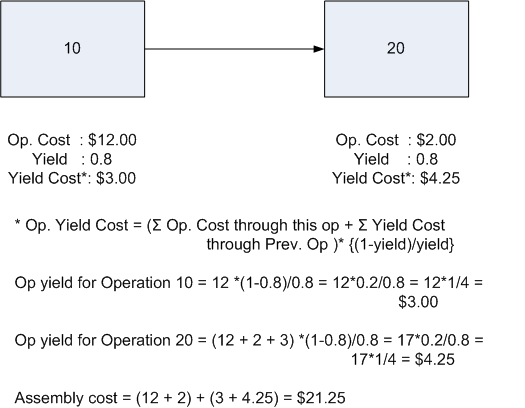
Setup
Actual Scrap account and Estimated Scrap Absorption Account are mandatory for every department.
Estimated Scrap Account is defined for the WIP Accounting Class. You can specify that the operation yield is to be considered while rolling up the cost for the assembly.
You can enable or disable estimated scrap accounting through Shop Floor Management Parameters. See: Defining Parameters
To enable Operation Yield for the operation:
-
Navigate to the Routings window in the Oracle Shop Floor Management menu
-
Enter item in the Item field
-
Select Operation Yield tab in the Operations region
-
Select Op Yield Enabled check box for the corresponding operation sequence
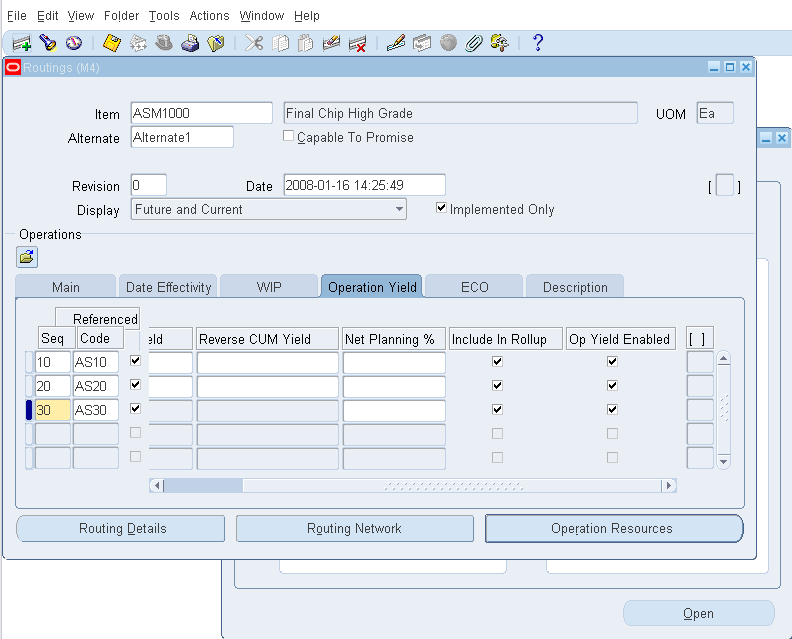
Estimated Scrap Accounting
You can track the difference between estimated scrap absorption and actual scrap according to departments. As lot progresses through operations, departmental Estimated Scrap Absorption Account receives a credit for the additional cost due to operation yield. The WIP Accounting Class Estimated Scrap Account gets a debit for the same amount.
Setup: Example

Estimated Scrap Accounting: Example
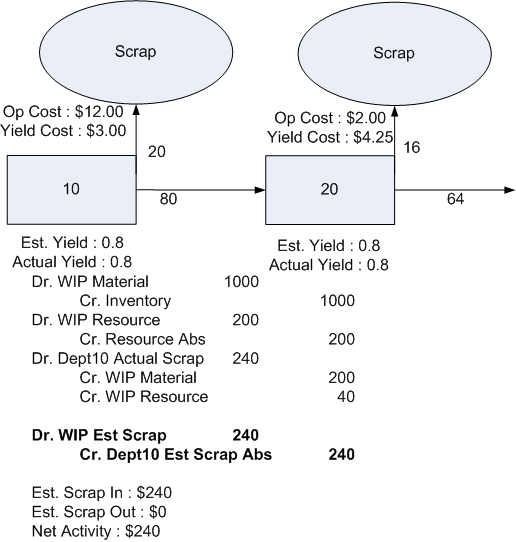
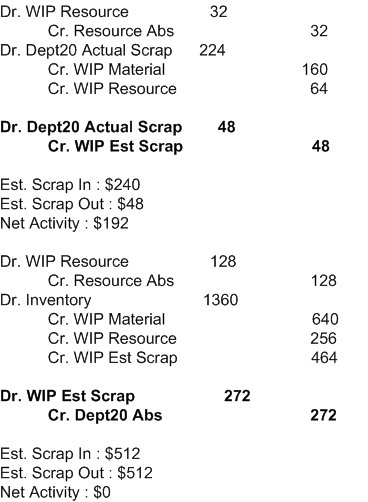
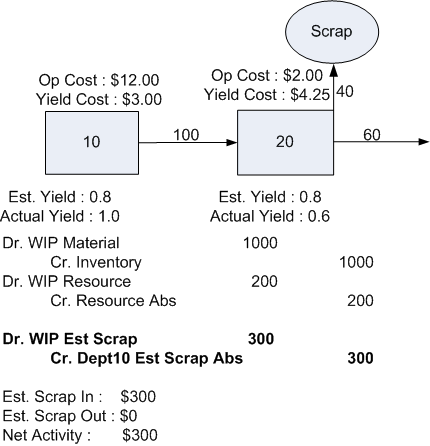
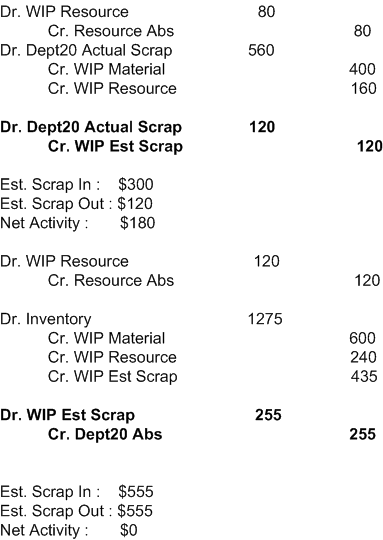
WIP Lot Transactions
In WIP Lot Transactions, only Split, Merge, Bonus, and Update Quantity affect costing.
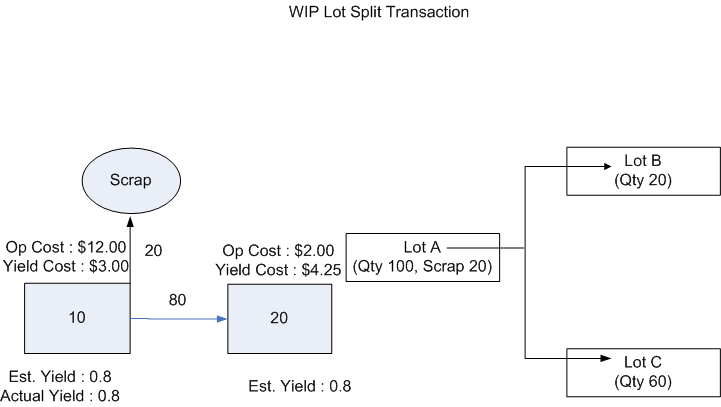
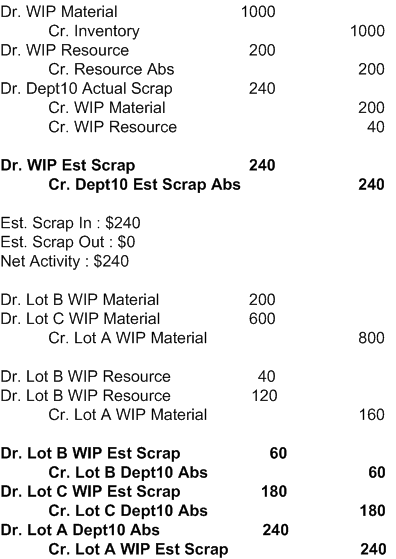
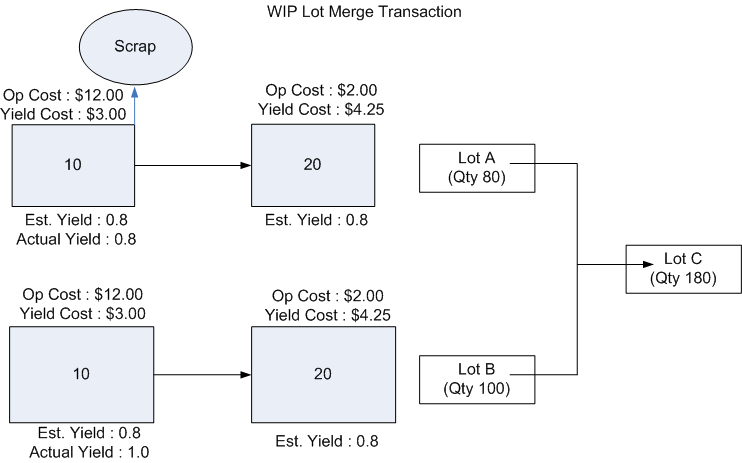



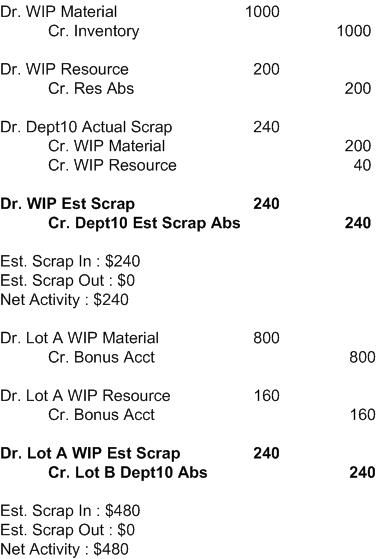
Disabling Estimated Scrap and Operation Yield Accounting
In some industries, such as the metals industry, there is no need to do estimated scrap absorption accounting as the scrapped items may be reused as a separate product. In addition, there may be no need to relieve cost from the job at the time of scrap.
You can choose to disable estimated scrap accounting for any organization to simplify accounting setups and variance analysis. The Estimated Scrap Accounting flag is on the Shop Floor Parameter window. You can change the value on this field only if all lot based jobs are in one of the following statuses - Unreleased, Closed, On hold, or Canceled.
If this field is set to enabled, the scrap transaction cost is relieved from the job and the scrap account is required on the Departments window. Estimated Scrap Accounting is performed as the job is moved from one operation to the next.
When it is set to disabled, there is no Estimated Scrap Accounting. The Estimated Scrap Absorption and the actual Scrap accounts are not required on the Departments window. Other aspects of this feature include:
-
You may rollup cost into an updateable Cost Type with or without operation yield costing.
-
The Assembly Cost Rollup does not change because cost is calculated based on the Include In Rollup and Operation Yield Enabled flags in the network routing. These flags are independent to the Estimated Scrap Accounting decision.
-
If the standard cost (Frozen Cost Type) is based on operation yield costing, the estimated scrap cost is included in the five cost elements for both Inventory Valuation and job completion costing. There will be no credit to the WIP Estimated Scrap Account for Assembly Completion transactions.
-
At the time of the scrap transaction, you can enter a scrap account on the Move Lot Based Jobs window to relieve costs from the work order. Generally, if your standard cost is based on Yield Costing, you will not provide a scrap account and leave the scrap in the job. If your standard cost is not based on Yield Costing, you will provide a scrap account and the job will be relieved of scrap. In either case, the quantity scrapped in the operation is updated.
-
The operation yield costing and scrap costing decision should be the same for an item. This consistency will reduce variance. However you may decide differently for different items.
Non Standard Expense Lot Based Jobs
Consider the following when working with non standard expense lot based jobs.
-
Non Standard Expense Lot Based Jobs disable Estimated Scrap accounting whether or not Estimate Scrap accounting is enabled at the Inventory Organization level.
-
Non Standard Expense Discrete Jobs are not earn Material Overhead on completion, and is not be revalued by standard cost update.
-
Unlike Non Standard Expense Discrete Jobs, variances in Non Standard Expense Lot Based Jobs are not flushed out at period close.
-
You can perform WIP lot transactions on non standard lot based jobs. The costing of these transactions is similar to that of standard lot based jobs.
WIP Lot Based Jobs Transaction Costing
There are seven types of WIP lot transactions available to lot based jobs including split, merge, update assembly, bonus, update routing, update quantity, and update lot number. WIP Lot Transaction can be done at the queue or to move intra-operation steps. However, it is not recommended that scrap transactions followed by WIP Lot transactions be performed at the queue intra-operation step.
Note: Performing scrap transactions in a separate operation allows for more intuitive costing.
During a lot's progression on the shop floor the following transactions have costing implications:
-
Lot Split Transactions
-
Lot Merge Transaction
-
Bonus Transactions
-
Update Quantity Transactions
Lot Based charges include lot based resources, lot based departmental overheads, and resource based overheads based on lot based resources.
Lot Split Transactions
When you divide a single parent lot into multiple child lots, the actual costs of materials and resources issued to the parent lot (including lot based resources and overheads) are reallocated to the child lots, based on the quantity ratios. The actual costs (the net value remaining in the parent lot) are reallocated to the child lots on a sub-elemental basis. If the net value for any sub-element is negative, it is not reallocated to the child lots and is remain in the parent.
At the time of a split, WIP Lot Spit transactions are created, that will adjust the WIP value of the parent lot and resulting lots with the appropriate balance.
Consider a lot A of size 10 with material charges of $100, items based resource charges of $50, and lot based resource charges of $50. One item is scrapped, resulting in a relief of $20.
The net balance in lot A is ($200 - $20) = $180.
If this lot were split into lot B of size 4 and lot C of size 5, the net balance is proportionally reallocated to the child lots. The parent receive a credit of $180, and the children receive a debit based on the quantity ratio:
Lot B receive a debit of (4/9) * $180 = $80
Lot C receive a debit of (5/9) * $180 = $100
The accounting entries are:
| Account | Debit | Credit |
|---|---|---|
| WIP Valuation Accounts for resulting lots | XX | |
| WIP Valuation Accounts for starting lot | XX |
The estimated scrap absorption in the parent is reversed for the charge that has been reallocated to the child lots. Each child lot receive a debit for the additional cost due to operation yield based on the charge that has been reallocated to it.
For the starting lot:
| Account | Debit | Credit |
|---|---|---|
| Department Estimated Scrap Absorption Account | XX | |
| WIP Valuation Estimated Scrap Accounts | XX |
For resulting lot:
| Account | Debit | Credit |
|---|---|---|
| WIP Valuation Estimated Estimated Scrap Account | XX | |
| Department Estimated Scrap Absorption Accounts | XX |
Note: Cost incurred by the scrapped quantity remain in lot A.
Merge Lots
When combining several lots into a single existing lot, the cost of materials and resources is reallocated to the resulting lot. The cost is proportionately reallocated to the resulting lot, based on the costs incurred by the representative lot. The net value in the representative lot is reallocated to the resulting lot on a sub-element basis. If the net value for any sub-element is negative, it is not reallocated to the resulting lot and will remain in the parent.
The lot based charges are not proportioned and the resulting lot incur the same lot based charges as the representative lot. Lot based charges incurred by the non-representative lots are not charged to the resulting lot.
Consider a lot A of size 10 with a material charge of $100, item based resource charges of $50. In addition, A has a charge of $100, which is incurred because component E was pushed to the lot.
Consider a lot B of size 10 with a material charge of $100, item based source charges of $50, and lot based resource charges of $50. In addition, B has a charge of $200, which it incurred because a different component F was pushed to the lot.
Merge lot A and B into a lot C of size 20. Choose A as the representative lot.
Since A is the representative lot, all charges in C are based on charges incurred by lot A. Hence lot C will receive a debit of: [(20/10) * (item based charged)] + (lot based charges) = [(20/10) * ($250)] + ($50) = $550.
Lot A receive a credit of: (10/20) * $500 +$50 = $300
Lot B receive a credit of: (10/20) * $500 = $250
The additional charges of $200 that was incurred by lot B, but not by lot A, remain in lot B. The lot based charges incurred by B is not charged to the resulting lot and remain in lot B. Lot B therefore have a net balance of $150.
The accounting entries are:
| Account | Debit | Credit |
|---|---|---|
| WIP Valuation Accounts for resulting lot | XX | |
| WIP Valuation Accounts for starting lots | XX |
The estimated scrap absorption in the starting lots are reversed for the charge that has been reallocated to the resulting lot. The resulting lot absorb the additional cost due to operation yield based on the charge that has been reallocated to it.
For the starting lots:
| Account | Debit | Credit |
|---|---|---|
| Department Estimated Scrap Absorption Account | XX | |
| WIP Valuation Estimated Scrap Accounts | XX |
For the resulting lot:
| Account | Debit | Credit |
|---|---|---|
| WIP Valuation Estimated Scrap Account | XX | |
| Department Estimated Scrap Absorption Account | XX |
Bonus Lots
You can create bonus lots to perform operations on assemblies that were previously scrapped. The quantity starts in the intraoperation step of queue of the starting operation. Therefore, components at the starting operation are not automatically charged when the bonus lot is created. The standard cost of the assembly through the previous operation is credited to the bonus account. The account is often the scrap account. Operation yield is calculated for all previous operations, based on standards.
Consider an assembly A with a component B ($10) and a resource R1 ($2) at operation 10. It also has a component C ($20) and a resource R2 ($1) at operation 20.
Create a bonus lot, lot-A of size 10 at operation 20. The lot incurs all charges in operation 10. Since the lot is at the intraoperation step of queue at operation 20, charges in operation 20 are not included in the bonus lot.
Hence lot-A incurs a charge of: 10 * $10 + 10 * $2 = $120.
The accounting entries are:
| Account | Debit | Credit |
|---|---|---|
| WIP Valuation Accounts for bonus lots | XX | |
| Bonus Account (user specified) | XX |
The bonus lot also receives a debit for the additional cost due to operation yield based on the charge that it has incurred.
| Account | Debit | Credit |
|---|---|---|
| WIP Valuation Estimated Scrap Account | XX | |
| Bonus Account (user specified) | XX |
Based on this, a job bonused in at sequence 10 (the first sequence) is like a new job that has just been opened. As this is the first operation in the routing there will not be any costs incurred from a previous operation. If it is opened at a later operation such as 20 it will incur the standard cost from 10 or up through the previous operation and not any cost for the current operation.
An example of how a bonus transaction should be done at an operation other than the first operation is shown in the following section:
-
Create a job with 1000 at operation 10, where 1000 components are issued to the job
-
Scrap 200 at operation 10 and complete 800 good at operation 10
-
Move 800 through operation 20 and complete
-
Bonus in a job of 200 at queue of 20. (It will be valued at standard cost as having completed operation 10 including starting material. The standard cost of the assembly through the previous operation is credited to the bonus account. The account is often the scrap account.)
-
Move 200 out of operation 20 and complete
Update Quantity
You can increase the quantity remaining in a job using the update quantity transaction. Cost incurred by the job (except lot based cost) will be proportionately debited to the job, based on the new quantity and the net value remaining in the job. The net value remaining in the parent job is reallocated on a sub-elemental basis. If the net value for any sub-element is negative, it is not reallocated to the resulting lot.
The lot based charges are not proportioned in the update lot.
The credit is to the account specified while creating the update quantity transaction and is often the scrap account.
Consider a lot A of size 10 with a material charge of $100, lot based resource charge of $50, and resource based overhead charges of $20 from overheads associated to the lot based resources.
Update the quantity in lot A to 20.
The cost incurred in the new lot is: [$100 * (20/10) + $50 + $20 = $270
The non-lot based charges of $100 are proportioned. The remaining lot based charges are not proportionate and remain in the job. Hence lot A receive a credit of $100.
The accounting for the new charges to the job are:
| Account | Debit | Credit |
|---|---|---|
| WIP Valuation Account | XX | |
| Bonus Account (user specified) | XX |
The updated lot also receive a debit for the additional cost due to operation yield based on the additional charge that it has occurred.
The accounting entries are:
| Account | Debit | Credit |
|---|---|---|
| WIP Valuation Estimated Scrap Account | XX | |
| Bonus Account (user specified) | XX |
Update Routing and Update Assembly
While performing update routing or update assembly transactions at the queue intra-operation step, if you have manual resources and overheads or push component on the current operation, you must manually reverse the charges.
Lot Based Transaction are Integrated into Cost Manager
All transactions for the lot based jobs, including WIP lot transactions, are costed by the cost manager. In the sequence in which they occurred. If costing fails for any of these transactions, all subsequent transactions for lot based jobs in that organization will be suspended until that error is corrected.
Transaction Import through MES
To correctly cost WIP lot transactions, it is essential to cost the transactions in a sequence. The cost manager sequentially cost all transactions based on the date on which they occurred. However, if a transaction with a prior date is imported through MES, there is a possibility that some subsequent WIP lot transactions on the job have already been costed. The WIP lot transactions are not reflex the late transactions.
If this timing problem is significant, you can use the date cutoff feature to shut off the cost manager until all relevant transaction on the job have been imported. You can set the date cutoff to process for anytime range you wish. This way all transactions are correctly processed in sequence. See: Cost Manager, Oracle Cost Management User's Guide.
WIP Value Summary
You can use the WIP Value Summary window to view cost elements, if transaction related to the job have been costed. The estimated scrap cost incurred and relieved is displayed in the Operation Yield tab. You can also drill down to the detailed accounting distributions that contributed to the WIP value.
Reports
The work in process reports enable you to view calculations of estimated scrap incurred, estimated scrap relieved, and estimated scrap variances on lot based jobs, in addition to the five cost elements (Material, Material Overhead, Resource, Overhead, Outside Processing). See: Discrete Job Value Report, Oracle Work in Process User's Guide.
You can analyze these cost by work order, as well as track departmental performance using the discrete job value report. See: WIP Value Report, Oracle Work in Process User's Guide.
For more information on Manufacturing Resources, Items, Constraint Types, and Oracle Advanced Supply Chain Planning, refer to Oracle Advanced Supply Chain Planning Implementation and User’s Guide, Oracle Risk Optimization User's Guide, and Oracle Global Order Promising Implementation and User's Guide.